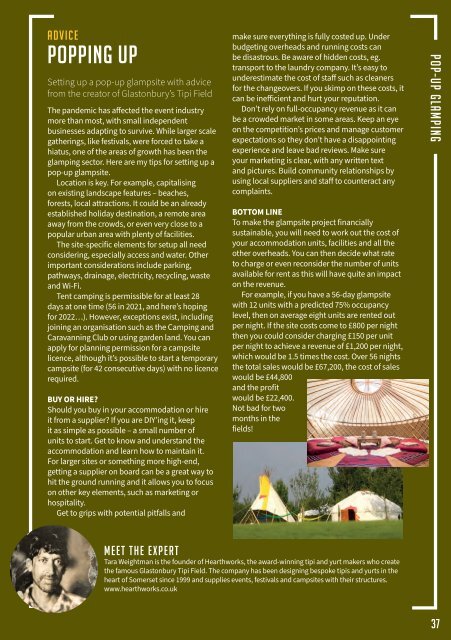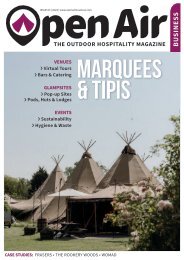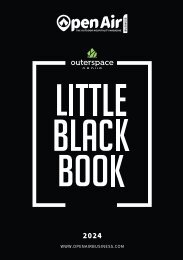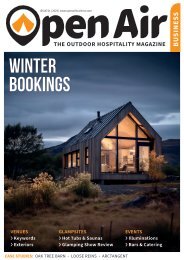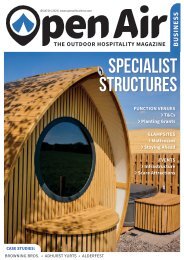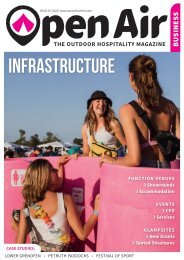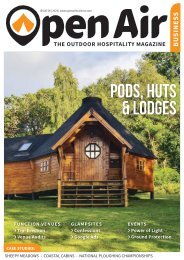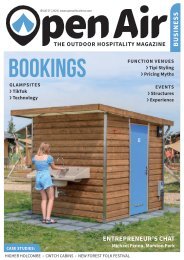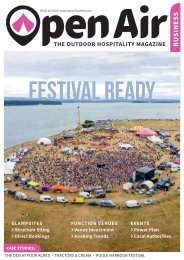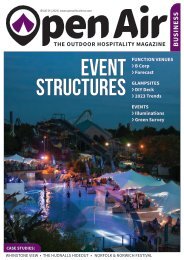Little Black Book of Glamping 2022
Everything you need to set up a glampsite - suppliers, expert knowledge and inspiration. From the publishers of Open Air Business magazine.
Everything you need to set up a glampsite - suppliers, expert knowledge and inspiration. From the publishers of Open Air Business magazine.
Create successful ePaper yourself
Turn your PDF publications into a flip-book with our unique Google optimized e-Paper software.
ADVICE<br />
Popping Up<br />
Setting up a pop-up glampsite with advice<br />
from the creator <strong>of</strong> Glastonbury’s Tipi Field<br />
The pandemic has affected the event industry<br />
more than most, with small independent<br />
businesses adapting to survive. While larger scale<br />
gatherings, like festivals, were forced to take a<br />
hiatus, one <strong>of</strong> the areas <strong>of</strong> growth has been the<br />
glamping sector. Here are my tips for setting up a<br />
pop-up glampsite.<br />
Location is key. For example, capitalising<br />
on existing landscape features – beaches,<br />
forests, local attractions. It could be an already<br />
established holiday destination, a remote area<br />
away from the crowds, or even very close to a<br />
popular urban area with plenty <strong>of</strong> facilities.<br />
The site-specific elements for setup all need<br />
considering, especially access and water. Other<br />
important considerations include parking,<br />
pathways, drainage, electricity, recycling, waste<br />
and Wi-Fi.<br />
Tent camping is permissible for at least 28<br />
days at one time (56 in 2021, and here’s hoping<br />
for <strong>2022</strong>…). However, exceptions exist, including<br />
joining an organisation such as the Camping and<br />
Caravanning Club or using garden land. You can<br />
apply for planning permission for a campsite<br />
licence, although it’s possible to start a temporary<br />
campsite (for 42 consecutive days) with no licence<br />
required.<br />
BUY OR HIRE?<br />
Should you buy in your accommodation or hire<br />
it from a supplier? If you are DIY’ing it, keep<br />
it as simple as possible – a small number <strong>of</strong><br />
units to start. Get to know and understand the<br />
accommodation and learn how to maintain it.<br />
For larger sites or something more high-end,<br />
getting a supplier on board can be a great way to<br />
hit the ground running and it allows you to focus<br />
on other key elements, such as marketing or<br />
hospitality.<br />
Get to grips with potential pitfalls and<br />
make sure everything is fully costed up. Under<br />
budgeting overheads and running costs can<br />
be disastrous. Be aware <strong>of</strong> hidden costs, eg.<br />
transport to the laundry company. It’s easy to<br />
underestimate the cost <strong>of</strong> staff such as cleaners<br />
for the changeovers. If you skimp on these costs, it<br />
can be inefficient and hurt your reputation.<br />
Don’t rely on full-occupancy revenue as it can<br />
be a crowded market in some areas. Keep an eye<br />
on the competition’s prices and manage customer<br />
expectations so they don’t have a disappointing<br />
experience and leave bad reviews. Make sure<br />
your marketing is clear, with any written text<br />
and pictures. Build community relationships by<br />
using local suppliers and staff to counteract any<br />
complaints.<br />
BOTTOM LINE<br />
To make the glampsite project financially<br />
sustainable, you will need to work out the cost <strong>of</strong><br />
your accommodation units, facilities and all the<br />
other overheads. You can then decide what rate<br />
to charge or even reconsider the number <strong>of</strong> units<br />
available for rent as this will have quite an impact<br />
on the revenue.<br />
For example, if you have a 56-day glampsite<br />
with 12 units with a predicted 75% occupancy<br />
level, then on average eight units are rented out<br />
per night. If the site costs come to £800 per night<br />
then you could consider charging £150 per unit<br />
per night to achieve a revenue <strong>of</strong> £1,200 per night,<br />
which would be 1.5 times the cost. Over 56 nights<br />
the total sales would be £67,200, the cost <strong>of</strong> sales<br />
would be £44,800<br />
and the pr<strong>of</strong>it<br />
would be £22,400.<br />
Not bad for two<br />
months in the<br />
fields!<br />
Pop-up <strong>Glamping</strong><br />
MEET THE EXPERT<br />
Tara Weightman is the founder <strong>of</strong> Hearthworks, the award-winning tipi and yurt makers who create<br />
the famous Glastonbury Tipi Field. The company has been designing bespoke tipis and yurts in the<br />
heart <strong>of</strong> Somerset since 1999 and supplies events, festivals and campsites with their structures.<br />
www.hearthworks.co.uk<br />
37


